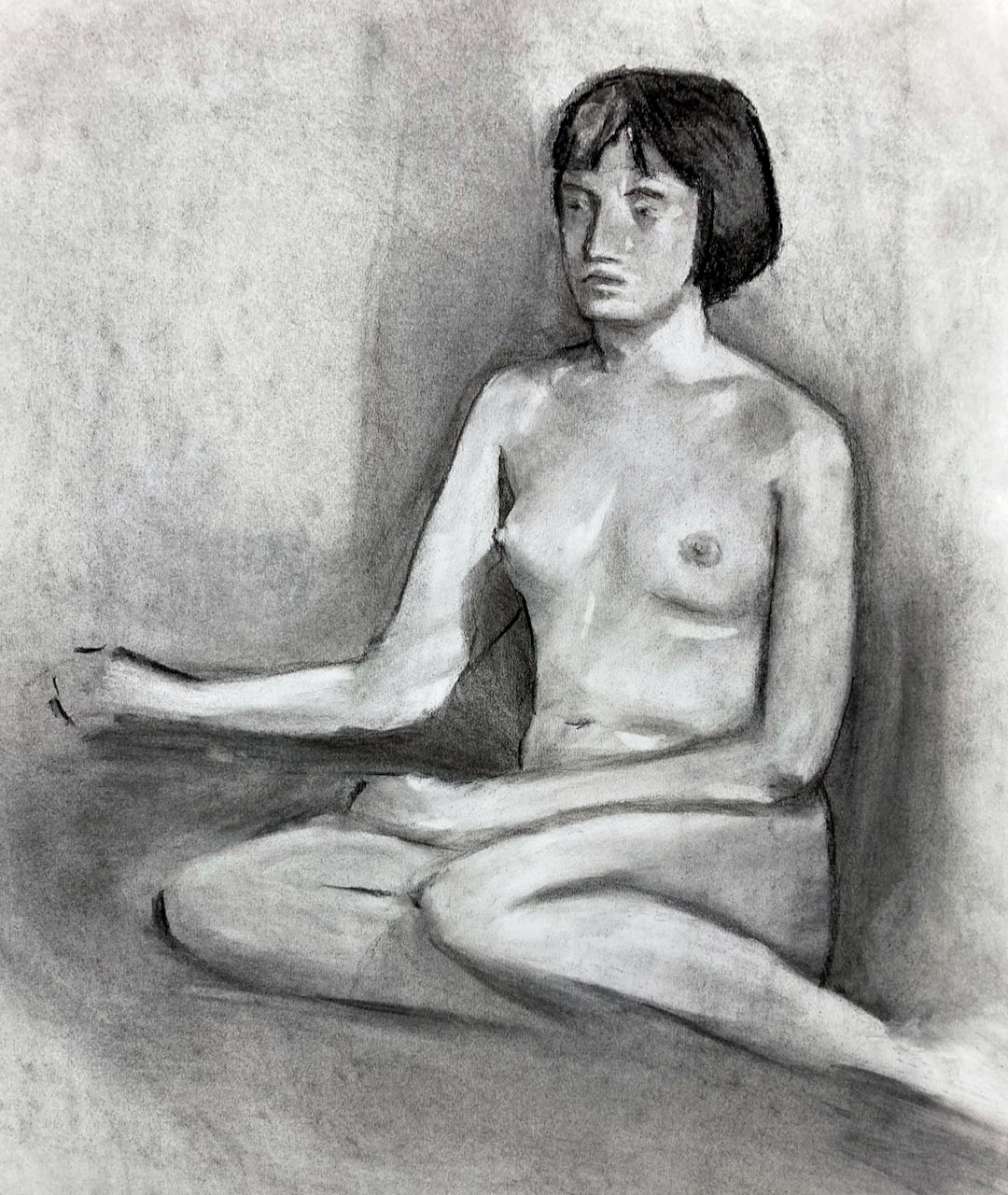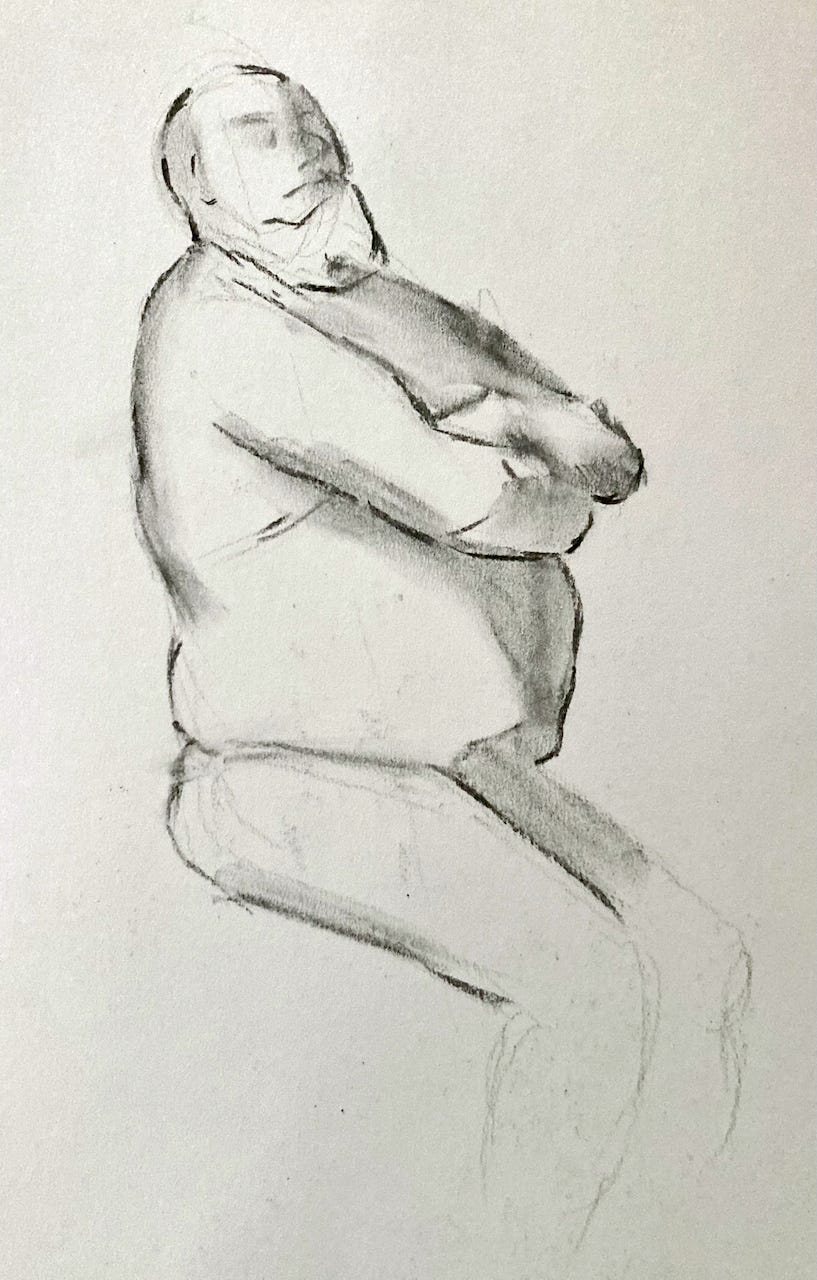The Figure
While I’ve been in London, I’ve been to a few figure drawing sessions. Drawing people, or figures, is a core part of drawing and painting training, but I’ve never had the opportunity to do it in earnest before now. The figure is often considered the most challenging subject, and therefore one of the best for training drawing skills.
During a figure drawing session, artists gather around a model, usually nude, who moves between various poses and holds them for varying amounts of time. Long poses of more than 20 minutes often have breaks, and poses can be very short, 30 seconds to 3 minutes.
London is a great city for figure drawing. I can find at least two or three sessions every day across the city, and life drawing modeling is a viable career, especially with the huge growth of online Zoom sessions since the pandemic.
Representational art genres are eternal. Landscapes, still lifes, portraits, figures, endlessly rediscovered in each generation since the beginning of art in the caves. I walk through the tube stations looking at advertisements, and I try to place each composition in a genre. Clothing ads are usually figures or portraits. Product ads are often still lifes, but sometimes figures as well. Landscapes are perhaps the rarest in advertising. Of course, photography is the most common medium for these genres now, followed by illustration. But their core concern is the same as it has always been—landscape, still life, people.
I’ve made portraits before, and many landscapes and still lifes. But this is the first time my attention is deeply focused on the bodies of my fellow humans (he said like an alien). And now I think it’s true what the past generations have said—the figure is the most challenging subject, and among the most instructive, and noble, to study.
I always believed that drawing was drawing. If you learned drawing skills, you could apply those skills to any subject from a landscape to an apple to a human face. As my teacher once said, “Subject matter doesn’t matter.” In many ways that’s true, there are core fundamentals that apply to all drawing and painting. If you have fundamentals, you don’t need specific tutorials or instruction to learn how to draw every potential subject on earth. “How to draw hands” and “how to draw heads” ends up in the same place. Learn the core drawing skills, and draw what you see directly. But, since creativity is a paradox, the opposite and contradicting point is also true. The subject does matter—the internal and external qualities of the subject matter, and the relationship between the artist’s mind and the subject also matters.
Everything depends on the attitude of the artist towards her subject. It is the one great essential.” –Robert Henri
Drawing something highly structural like a building requires a certain mindset and approach, compared to drawing something more organic and fluid, like foliage along a riverbank. When drawing structures, the mind and drawing approach becomes more structured, and when drawing moving, living organisms, the mind becomes more full of motion and fluidity. Of course, all rigid structures have some dynamic, organic qualities, and all living, organic things have static structure. There’s a matrix between a rock and a leaf in varying degrees of structure and movement. A rock just lives more slowly than the leaf. The rock is highly structural and slowly fluid. The leaf is moderately structural and highly fluid.
The human figure is highly structural and highly fluid at the same time. If you draw using only a structural mindset, the form will feel off, devoid of the vibrant, dynamic life we actually perceive when we see another human. But if you try to draw using only the fluid mindset, the form will appear fleeting, ghostlike, more like smoke than a person. Tiny inaccuracies in the structure of the figure stand out and pull the eye away from the overall form. So the human form requires the fullest range of artistic perception, skill, and mindset to be integrated, from deeply logical, careful, and structural, to deeply intuitive, fast, and fluid.
This range can be seen in the vast array of styles in figure drawing that have been made over centuries. Classicists emphasize the structural. Romantics emphasize the organic. Modernists emphasize neither—only symbol and concept through abstraction.
The figure is also highly complex and detailed. It’s packed with information and layered forms, and fine details that we’re especially tuned to notice and want to capture. We are keenly interested in the nuances of other humans’ body language and appearance. It’s a subject we begin our obsession with at birth, and never grow tired of. This is another challenge for the artist—trying to capture all the detail is a classic beginner mistake, and learning to simplify the forms is a core skill. With the limited time we have and the endless amount of interesting details we perceive, how do we learn to efficiently record our perceptions, accurately build the figure’s structure, and reflect the drama, wholeness, and aliveness of the human kind enough to model for us?
So, I’m exploring that question now. Drawing figures has already taught me many technical skills I’ve been able to apply to other genres like landscape and still life. And I’m eager to learn more about wholeness and creative skills along the way. I’m also brought into direct confrontation with my preconceptions and misconceptions about other people and our bodies. Drawing someone from life, I’m often overwhelmed by the depth of aliveness, complexity, intelligence, and intuition I perceive, and their generosity in being willing to model. As objectively I look at the human form as lines, shape, light, and shadow, there’s a gentle familiarity that comes from painting someone—you can get to know someone through their portrait, for sure.








